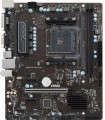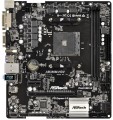Power phases
The number of processor power phases provided on the motherboard.
Very simplistically, phases can be described as electronic blocks of a special design, through which power is supplied to the processor. The task of such blocks is to optimize this power, in particular, to minimize power surges when the load on the processor changes. In general, the more phases, the lower the load on each of them, the more stable the power supply and the more durable the electronics of the board. And the more powerful the CPU and the more cores it has, the more phases it needs; this number increases even more if the processor is planned to be overclocked. For example, for a conventional quad-core chip, only four phases are often enough, and for an overclocked one, at least eight may be needed. It is because of this that powerful processors can have problems when used on inexpensive low-phase motherboards.
Detailed recommendations on choosing the number of phases for specific CPU series and models can be found in special sources (including the documentation for CPU itself). Here we note that with numerous phases on the motherboard (more than 8), some of them can be virtual. To do this, real electronic blocks are supplemented with doublers or even triplers, which, formally, increases the number of phases: for example, 12 claimed phases can represent 6 physical blocks with doublers. However, virtual phases are much inferior to real ones in terms of capabilities — in fact, t...hey are just additions that slightly improve the characteristics of real phases. So, let's say, in our example, it is more correct to speak not about twelve, but only about six (though improved) phases. These nuances must be specified when choosing a motherboard.
Size (HxW)
Motherboard dimensions in height and width. It is assumed that the traditional placement of motherboards is vertical, so in this case one of the dimensions is called not the length, but the height.
Motherboard sizes are largely determined by their form factors (see above), however, the size of a particular motherboard may differ slightly from the standard adopted for this form factor. In addition, it is usually easier to clarify the dimensions according to the characteristics of a particular motherboard than to look for or remember general information on the form factor. Therefore, size data can be given even for models that fully comply with the standard.
The third dimension — thickness — is considered less important for a number of reasons, so it is often omitted.
Max. clock frequency
The maximum RAM clock speed supported by the motherboard. The actual clock frequency of the installed RAM modules should not exceed this indicator — otherwise, malfunctions are possible, and the capabilities of the “RAM” cannot be used to the fullest.
For modern PCs, a RAM frequency of
1500 – 2000 MHz or
less is considered very low,
2000 – 2500 MHz is modest,
2500 – 3000 MHz is average,
3000 – 3500 MHz is above average, and the most advanced boards can support frequencies of
3500 – 4000 MHz and even
more than 4000 MHz.
M.2 connector
The number of M.2 connectors provided in the design of the motherboard. There are
motherboards for 1 M.2 connector,
for 2 connectors,
for 3 connectors or more.
The
M.2 connector is designed to connect advanced internal devices in a miniature form factor — in particular, high-speed SSD drives, as well as expansion cards like Wi-Fi and Bluetooth modules. However, connectors designed to connect only peripherals (Key E) are not included in this number. Nowadays, this is one of the most modern and advanced ways to connect components. But note that different interfaces can be implemented through this connector — SATA or PCI-E, and not necessarily both at once. See "M.2 interface" for details; here we note that SATA has a low speed and is used mainly for low-cost drives, while PCI-E is used for advanced solid-state modules and is also suitable for other types of internal peripherals.
Accordingly, the number of M.2 is the number of components of this format that can be simultaneously connected to the motherboard. At the same time, many modern boards, especially mid-range and top-end ones, are equipped with
two or more M.2 connectors, and moreover, with PCI-E support.
M.2
Electrical (logical) interfaces implemented through physical M.2 connectors on the motherboard.
See above for more details on such connectors. Here we note that they can work with two types of interfaces:
- SATA is a standard originally created for hard drives. M.2 usually supports the newest version, SATA 3; however, even it is noticeably inferior to PCI-E in terms of speed (600 MB / s) and functionality (only drives);
- PCI-E is the most common modern interface for connecting internal peripherals (otherwise NVMe). Suitable for both expansion cards (such as wireless adapters) and drives, while PCI-E speeds allow you to fully realize the potential of modern SSDs. The maximum communication speed depends on the version of this interface and on the number of lines. In modern M.2 connectors, you can find PCI-E versions 3.0 and 4.0, with speeds of about 1 GB / s and 2 GB / s per lane, respectively; and the number of lanes can be 1, 2 or 4 (PCI-E 1x, 2x and 4x respectively)
Specifically, the M.2 interface in the characteristics of motherboards is indicated by the number of connectors themselves and by the type of interfaces provided for in each of them. For example, the entry "3xSATA / PCI-E 4x" means three connectors that can work both in SATA format and in PCI-E 4x format; and the designation "1xSATA / PCI-E 4x, 1xPCI-E 2x" means two connectors, one of which works as SATA or PCI-E 4x, and the second — only as PCI-E 2x.
1x PCI-E slots
Number of PCI-E (PCI-Express) 1x slots installed on the motherboard. There are
motherboards for 1 PCI-E 1x slot,
2 PCI-E 1x slots,
3 PCI-E 1x ports and even more.
The PCI Express bus is used to connect various expansion cards — network and sound cards, video adapters, TV tuners and even SSD drives. The number in the name indicates the number of PCI-E lines (data transfer channels) supported by this slot; the more lines, the higher the throughput. Accordingly, PCI-E 1x is the basic, slowest version of this interface. The data transfer rate for such slots depends on the PCI-E version (see "PCI Express Support"): in particular, it is slightly less than 1 GB / s for version 3.0 and slightly less than 2 GB / s for 4.0.
Separately, we note that the general rule for PCI-E is as follows: the board must be connected to a slot with the same or more lines. Thus, only single-lane boards will be guaranteed to be compatible with PCI-E 1x.
Steel PCI-E connectors
The presence of reinforced
steel PCI-E connectors on the "motherboard".
Such connectors are found mainly in gaming (see "In the direction") and other advanced varieties of motherboards, designed to use powerful graphics adapters. Steel slots are usually made PCI-E 16x, just designed for such video cards; in addition to the slot itself, its attachment to the board also has a reinforced design.
This feature offers two key advantages over traditional plastic connectors. Firstly, it allows you to install even large and heavy video cards as reliably as possible, without the risk of damaging the slot or board. Secondly, the metal connector plays the role of a protective screen and reduces the likelihood of interference; this is especially useful when using multiple video cards installed side by side.
USB 2.0
The number of USB 2.0 connectors provided on the motherboard.
USB connectors (all versions) are used to connect to the "motherboard" USB ports located on the front panel of the case. With a special cable, such a port is connected to the connector, while one connector, usually, works with only one port. In other words, the number of connectors on the motherboard corresponds to the maximum number of front USB connectors that can be used with it.
Specifically, USB 2.0 is the oldest version widely used nowadays. It provides data transfer rates up to 480 Mbps, is considered obsolete and is gradually being replaced by more advanced standards, primarily USB 3.2 gen1 (formerly USB 3.0). Nevertheless, a lot of peripherals are still being produced under the USB 2.0 connector: the capabilities of this interface are quite enough for most devices that do not require a high connection speed.
USB 3.2 gen1
The number
of USB 3.2 gen1 connectors provided on the motherboard.
USB connectors (all versions) are used to connect to the "motherboard" USB ports located on the outside of the case (usually on the front panel, less often on the top or side). With a special cable, such a port is connected to the connector, while one connector, usually, works with only one port. In other words, the number of connectors on the motherboard corresponds to the maximum number of case USB connectors that can be used with it. At the same time, we note that in this case we are talking about traditional USB A connectors; connectors for newer USB-C are mentioned separately in the specifications.
Specifically, USB 3.2 gen1 (formerly known as USB 3.1 gen1 and USB 3.0) provides transfer speeds of up to 4.8 Gbps and more power than the earlier USB 2.0 standard. At the same time, USB Power Delivery technology, which allows you to reach power up to 100 W, is usually not supported by this version of USB A connectors (although it can be implemented in USB-C connectors).

